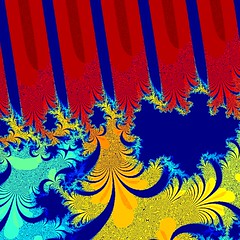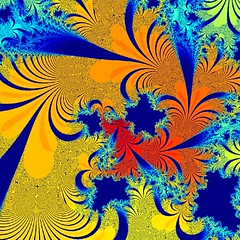December 22, 2007
Fibonacci Fractals and Golden Cosmology
Here are some Newtonmas fractals, based on the de Moivre-Binet formula for Fibonacci numbers:
z(n+1)=(phi^n - (-phi)^n)/sqrt(5)
It has two attractors, 1 and infinity. Like sin(z), exp(z) and cosh(z) we get a "palm frond" structure of points escaping towards infinity along the positive or negative direction, but also small clouds not looking too dissimilar from Julia sets from the main Mandelbrot cardioid.
I got the idea of looking at the function from seeing the paper The Golden Section, Fibonacci series and new hyperbolic models of Nature by Alexey Stakhov and Boris Rozin. They define hyperbolic Fibonacci sines and cosines by analogy with the hyperbolic sine and cosine, showing a number of nice identities.
They also unfortunately succumb to the temptation - endemic among everybody working with the golden ratio - of assuming that these results have some kind of cosmological significance. Yes, the golden ratio and Fibonacci numbers are ubiquitous. But that just means that if they show up in cosmology we should be unsurprised. But I have no doubt that some people would reject a cosmological or fundamental physics theory because it involved a rare or "boring" constant like 4/5 or 17. Or maybe one could make a maximum entropy argument, and claim that the most a priori likely theory has the most a priori likely component constants?

